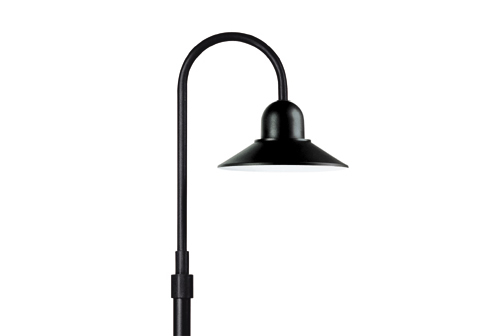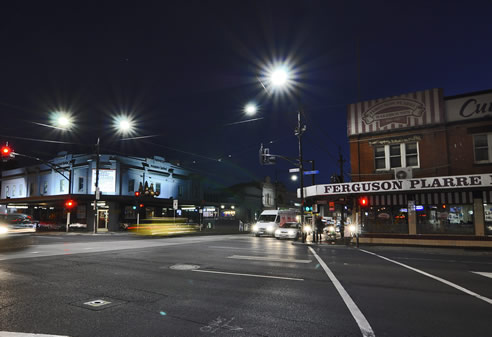The project was notable on a number of counts. Foremost, the job was complex as it required lighting supplier WE-EF to be flexible and able to respond to the diverse needs of numerous stakeholders. In addition, creating a custom LED product that met the stringent criteria of not only those responsible for the 'poles and wires' on this stretch of road, but also those of road, rail and tram transportation authorities, was a complicated task. The lighting product also had to meet the Australian Standard (V3) for lighting roads and public spaces (under AS/NZ1158.1) - a factor that set WE-EF apart from all other suppliers of top-end decorative products on the market.

Sydney Road in Coburg VIC before the lighting upgrade - with 150 W high-pressure sodium lamps, day-time and night-time view.
Moreland City Council chose to work with WE-EF via its sales partner, Buckford Illumination Group, to provide a compliant solution. WE-EF LIGHTING is a local Melbourne manufacturer of exterior lighting and has the facilities and expertise to customise luminaire optics and luminaire design for project-specific requirements. As part of the Coburg Beautification Programme, this project specified a 4000 K LED. The improvement in colour rendering between the existing high-pressure sodium lighting and the new installation is dramatic.
"One of the main challenges of the project was to change to LED luminaires while maintaining the same pole position - so-called one-for-one replacement," explained Ms. Alena Leonardi, Marketing Manager at WE-EF. She added that the poles could not be replaced as they also provide infrastructure for the tramline running along the middle of Sydney Road.
The location of the project is a two-way traffic street, with parking bays on both sides and tramlines in the middle of the road. For such a relatively wide area, and to be able to use the existing pole locations, WE-EF Lighting proposed a so-called 'hybrid' solution of nine [R65] rectangular lenses and six [A60] 'forward throw' lenses - a variation on the ASP530 post top luminaire - to achieve the distribution pattern suitable for the project requirements.

The WE-EF ASP530 LED luminaire with the patented WE-EF 'butterfly' LED lenses, suitable for the Category 'P' lighting market in Australia.
Technology and design combined
The WE-EF winning proposal satisfied the criteria of not only various transport authorities and Moreland City Council but the utility company Jemena. The design of this customised product involved blending of the two optics and operating them at a non-standard drive current of 800 mA. To achieve the minimum and average lighting parameters, the 45 XM-L LED chips were operated at 800mA, with maximum LED junction temperature [Tj] of 85oC, achieving the system wattage of 118 W per fitting - around 25 per cent more energy-efficient than the original 150 W high-pressure sodium luminaire.
The ASP530 product is a WE-EF 'bell-shaped' luminaire, originally designed for use with conventional lamp technology combined with a reflector. In 2012, as part of the 'LED revolution' in the exterior lighting market, the ASP530 luminaire was converted to LED technology by using the patented WE-EF 'butterfly' LED lenses, suitable for the Category 'P' lighting market in Australia. Each lens replicates the performance of the other and combined with sophisticated electronics, translates into highly customisable solutions.
'Butterfly' lenses come in sets of three modules, designed specifically for six different street and area lighting applications - from bicycle lane to car park lighting. The lens varieties and its modularity allow combinations of different optics to create distributions tailored to a particular illumination area, which was exactly what was required by the Sydney Road project. Additionally, the LED version of the luminaire provides an efficient alternative to luminaires equipped with 42 W compact fluorescent, 35-70 W metal halide or 80 W mercury vapour lamps.
30 ASP530 LED luminaires were successfully installed in October 2014.







 Modern Catenary Solution Fit for
Modern Catenary Solution Fit for WE-EF's New Managing Director for
WE-EF's New Managing Director for A New Era for WE-EF LIGHTING – A Home
A New Era for WE-EF LIGHTING – A Home Myers Park Lighting Upgrade:
Myers Park Lighting Upgrade: Bridging the Past and Future: Old Murray
Bridging the Past and Future: Old Murray WE-EF Profile Projectors for Sharper
WE-EF Profile Projectors for Sharper Award-winning Bay Pavilions, Arts +
Award-winning Bay Pavilions, Arts + Enhancing Transit Experience at Byron
Enhancing Transit Experience at Byron Intelligently Illuminating the Bay Run
Intelligently Illuminating the Bay Run WE-EF Lighting's Role in Protecting
WE-EF Lighting's Role in Protecting Sustainable LED Upgrade Kit from WE-EF
Sustainable LED Upgrade Kit from WE-EF A Natural Paradise Rottnest Island by
A Natural Paradise Rottnest Island by WE-EF LIGHTING's Braeside Expansion
WE-EF LIGHTING's Braeside Expansion Street and Area Pole-Mounted Luminaires
Street and Area Pole-Mounted Luminaires Smart Lighting Control Technology from
Smart Lighting Control Technology from High-Output Floodlights with Modern LED
High-Output Floodlights with Modern LED Bondi Beach Pavilion Reimagined by WE-EF
Bondi Beach Pavilion Reimagined by WE-EF Balancing Needs: Sea Turtle Conservation
Balancing Needs: Sea Turtle Conservation Architecturally Pleasing Recessed
Architecturally Pleasing Recessed Luminaires for Lake Macquarie Multi-Arts
Luminaires for Lake Macquarie Multi-Arts
